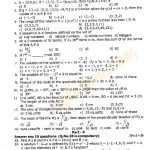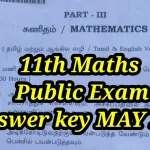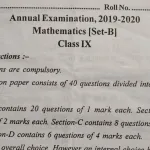The 12th public examination plays an essential role in shaping the academic future of students. It is crucial for students to prepare effectively for the exam by understanding the types of questions that may be asked. This guide provides a series of questions and answers across all subjects typically covered in the 12th public exam, helping students to enhance their preparation.
Subject: Mathematics
Question: What is the formula for the area of a triangle?
Answer: The formula for the area of a triangle is (1/2) × base × height.
Question: How do you find the discriminant of a quadratic equation?
Answer: The discriminant of a quadratic equation ax2+bx+c=0ax^2 + bx + c = 0 is found using the formula D=b2−4acD = b^2 – 4ac.
Question: Define a function in mathematics.
Answer: A function is a relation between a set of inputs and a set of possible outputs, where each input is related to exactly one output.
Question: What is the Pythagorean theorem?
Answer: The Pythagorean theorem states that in a right-angled triangle, the square of the hypotenuse is equal to the sum of the squares of the other two sides.
Question: Explain the concept of probability.
Answer: Probability is the measure of the likelihood that an event will occur, calculated by dividing the number of favorable outcomes by the total number of possible outcomes.
Question: What is a logarithm?
Answer: A logarithm is the inverse operation to exponentiation. It determines the power to which a number must be raised to obtain another number.
Question: How do you calculate the derivative of a function?
Answer: The derivative of a function can be calculated using basic rules of differentiation, such as the power rule, product rule, and chain rule.
Question: What is the difference between mean, median, and mode?
Answer: The mean is the average of a set of numbers, the median is the middle value when numbers are arranged in order, and the mode is the value that appears most frequently.
Question: What is the formula for the area of a circle?
Answer: The formula for the area of a circle is A=πr2A = \pi r^2, where rr is the radius of the circle.
Question: Define a matrix.
Answer: A matrix is a rectangular array of numbers arranged in rows and columns that can be used to solve systems of linear equations.
Question: What is the difference between a scalar and a vector?
Answer: A scalar is a quantity with only magnitude, while a vector is a quantity that has both magnitude and direction.
Question: What is integration in mathematics?
Answer: Integration is the process of finding the integral of a function, which represents the area under the curve of that function.
Question: How do you solve a system of linear equations?
Answer: A system of linear equations can be solved using methods such as substitution, elimination, or matrix operations.
Question: What is a polynomial?
Answer: A polynomial is an algebraic expression consisting of variables, coefficients, and exponents combined using addition, subtraction, and multiplication.
Question: Explain the concept of vectors in two dimensions.
Answer: Vectors in two dimensions are quantities that have both magnitude and direction, represented as an ordered pair (x, y).
Question: What is the principle of mathematical induction?
Answer: The principle of mathematical induction is a proof technique used to prove that a statement holds true for all natural numbers.
Question: What is the solution to the equation x2−5x+6=0x^2 – 5x + 6 = 0?
Answer: The solution to the quadratic equation x2−5x+6=0x^2 – 5x + 6 = 0 is x=2x = 2 or x=3x = 3.
Question: Define trigonometric functions.
Answer: Trigonometric functions are mathematical functions related to the angles of a triangle, including sine, cosine, tangent, and their reciprocals.
Question: What is the formula for compound interest?
Answer: The formula for compound interest is A=P(1+rn)ntA = P(1 + \frac{r}{n})^{nt}, where AA is the amount, PP is the principal, rr is the rate, nn is the number of times interest is compounded per year, and tt is the time in years.
Question: What is a quadratic function?
Answer: A quadratic function is a polynomial function of degree 2, usually expressed as f(x)=ax2+bx+cf(x) = ax^2 + bx + c, where aa, bb, and cc are constants.
Question: How do you find the inverse of a function?
Answer: To find the inverse of a function, you exchange the dependent and independent variables, and then solve for the new dependent variable.
Question: What is an arithmetic progression?
Answer: An arithmetic progression is a sequence of numbers in which the difference between consecutive terms is constant.
Subject: Physics
Question: What is Newton’s first law of motion?
Answer: Newton’s first law states that an object will remain at rest or in uniform motion unless acted upon by an external force.
Question: What is the formula for work done?
Answer: The formula for work done is W=F×d×cos(θ)W = F \times d \times \cos(\theta), where WW is work, FF is force, dd is distance, and θ\theta is the angle between the force and the direction of motion.
Question: Define acceleration.
Answer: Acceleration is the rate of change of velocity per unit of time.
Question: What is the law of conservation of energy?
Answer: The law of conservation of energy states that energy cannot be created or destroyed, only transformed from one form to another.
Question: What is Ohm’s law?
Answer: Ohm’s law states that the current passing through a conductor is directly proportional to the voltage across it and inversely proportional to its resistance.
Question: What is the formula for gravitational force?
Answer: The formula for gravitational force is F=Gm1m2r2F = \frac{Gm_1m_2}{r^2}, where GG is the gravitational constant, m1m_1 and m2m_2 are the masses of two objects, and rr is the distance between them.
Question: What is the difference between speed and velocity?
Answer: Speed is a scalar quantity that measures how fast an object is moving, while velocity is a vector quantity that describes the speed in a specific direction.
Question: Define momentum.
Answer: Momentum is the product of an object’s mass and its velocity, expressed as p=mvp = mv.
Question: What is the principle of superposition?
Answer: The principle of superposition states that when two or more waves overlap, the resulting wave is the sum of the displacements of the individual waves.
Question: What is the formula for kinetic energy?
Answer: The formula for kinetic energy is KE=12mv2KE = \frac{1}{2}mv^2, where mm is the mass and vv is the velocity of the object.
Question: What is the difference between transverse and longitudinal waves?
Answer: In transverse waves, the particles move perpendicular to the direction of wave propagation, while in longitudinal waves, the particles move parallel to the direction of wave propagation.
Question: What is the unit of electric charge?
Answer: The unit of electric charge is the Coulomb (C).
Question: What is the formula for electric power?
Answer: The formula for electric power is P=VIP = VI, where PP is power, VV is voltage, and II is current.
Question: Explain the concept of refraction.
Answer: Refraction is the bending of light as it passes from one medium to another with a different refractive index.
Question: What is the SI unit of force?
Answer: The SI unit of force is the Newton (N).
Question: Define the work-energy theorem.
Answer: The work-energy theorem states that the work done on an object is equal to the change in its kinetic energy.
Question: What is the speed of light in a vacuum?
Answer: The speed of light in a vacuum is approximately 3×1083 \times 10^8 meters per second.
Question: What is the law of reflection?
Answer: The law of reflection states that the angle of incidence is equal to the angle of reflection.
Question: What is the significance of Planck’s constant?
Answer: Planck’s constant relates the energy of a photon to its frequency, and it is a fundamental constant in quantum mechanics.
Question: What is the formula for work done by a gas?
Answer: The formula for work done by a gas during expansion or compression is W=PΔVW = P \Delta V, where PP is the pressure and ΔV\Delta V is the change in volume.
The preparation for the 12th public exams involves understanding various topics across different subjects. By practicing questions like the ones above, students can strengthen their knowledge and perform better in their exams. Keep practicing regularly, and success will follow.
Latest Posts
- Step-by-step guide to download and apply for jee mains admit card 202
- Comprehensive 2025 government holidays and recruitment details for job seekers
- JEE Mains Admit Card 2025: Your Step-by-Step Guide to Downloading the Hall Ticket
- Everything You Need to Know About 2025 Government Holidays Recruitment
- Comprehensive Guide to rrb d group recruitment 2025 – Eligibility, Vacancies, and Application
- Detailed guide to nps trust recruitment 2025 vacancies, eligibility and apply process
- Comprehensive guide to hpcl recruitment 2025 notification, vacancies, and application process
- ignou bed admission 2025 complete recruitment guide with eligibility and process
- Comprehensive Guide to Indian Army Agniveer Recruitment 2025 Notification and Jobs
- Everything You Must Know About CBSE Board Exams 2025 Changes & New Rules






